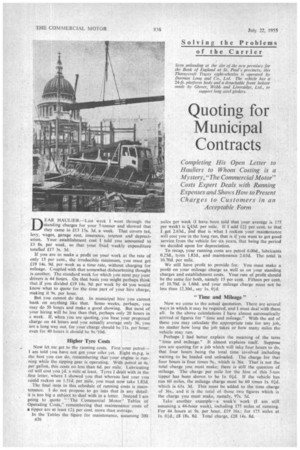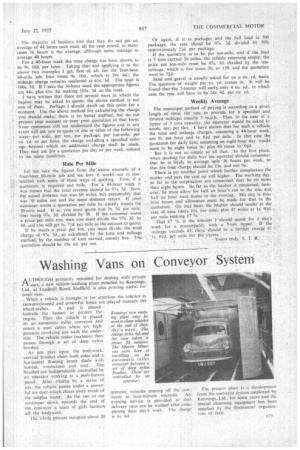Quoting for Municipal Contracts
Page 60

Page 63

If you've noticed an error in this article please click here to report it so we can fix it.
Completing His Open Letter to Hauliers to Whom Costing is a Mystery, "The Commercial Motor" Costs Expert Deals with Running Expenses and Shows How to Present Charges to Customers in an Acceptable Form.
DEAR HAULIER.—Last week I went through the standing charges for your 5-tortner and showed that they came to £13 15s. 3d. a week. That covers tax, levy, wages, garage rent, insurance, interest and depreciation. Your establishment cost I told you amounted to £3 8s. per week, so that your fixed, weekly expenditure totalled £17 3s. 3d.
If you are to make a profit on your work at the rate of only 15 per cent., the irreducible minimum, you must get £19 14s. 9d. per week as a time rate, without charging for mileage. Coupled with that somewhat disheartening thought is another. The standard week for which you must pay your drivers is 44 hours. On that basis you might perhaps think that if you divided £19 14s. 9d. per week by 44 you would know what to quote for the time part of your hire charge, making it 9s. per hour.
But you cannot do that. In municipal hire you cannot bank on anything like that. Some weeks, perhaps, you may do 50 hours and make a good showing. But most of your hiring will be less than that, perhaps only 20 hours in a week. If, when you are quoting, you base -i'our proposed charge on 44 hours and you actually average only 36, you are a long way out, for your charge should be Ils. per hour: even for 40 hours it should be 9s.-10d.
Higher Tyre Costs
Now let me get to the running costs. First your petrol . I am told you have not got your oiler yet. Eight m.p.g. is the best you can do. remembering that your engine is running while the tipping gear is operating. With petrol at 4s. per gallon, this costs no less than 6d. per mile. Lubricating oil will cost you id. a mile at least. Tyres I dealt with in the first letter, where I showed you that whereas last year you could reckon on 1.51d. per mile, you must now take 1.82d.
The final item in this schedule of running costs is maintenance. I do not propose to go into that in any detail: it is too big a subject to deal with in a letter. Instead I am going to quote " 'The Commercial Motor' Tables of Operating Costs." remembering that maintenance costs of a tipper are at least 12i per cent. more than average.
In the Tables the figure for maintenance, assuming 200 11-'6 miles per week (I have been told that your average is 175 per week) is 7,i43c1. per mile. lf I add 121 per cent, to that I get 2.63d., and that is what 1 reckon your maintenance will cost you in the long run, that is if you want to get good service from the vehicle for six years, that being the period we decided upon for depreciation.
To recap, your running costs are petrol 6.00d., lubricants 0.25d., tyres I.82d., and maintenance 2.63d. The total is 10.70d. per mile.
We still have profit to provide for. You must make a profit on your mileage charge as well as on your standing charges and establishment costs. Your rate of profit should be the same for both, namely 15 per cent. Fifteen per cent. of 10.70d. is 1.60d. and your mileage charge must not be less than 12.30d., say Is. 0.1d.
"Time and Mileage" '
Now we come to the actual quotation. There are several ways in which it may be required, and 1 must deal with them all. In the above calculations I have almost automatically arrived at figures for "time and mileage." With the aid of these you may calculate the appropriate rate for any job, no matter how long the job takes or how many miles the vehicle may run.
Perhaps I had better explain the meaning of the term "time and mileage." It almost explains itself. Suppose you are quoting for a job which will take four hours to do, that four hours being the total time involved including waiting to be loaded and unloaded. The charge for that four hours is four times 9s., which is 36s. That is not the total charge you must make; there is still the question of mileage. The charge per mile for the hire of this 5-ton tipper has been shown to be Is. Old. If the vehicle has run 60 miles, the mileage charge must be 60 times Is. 0,1d. which is 61s. 3d. This must be added to the -time charge of 36s., and it is the total of those two figures which is the charge you must make, namely, 97s. 3d.
Take another example—a week's work (I am still assuming a 44-hour week), including 175 miles of running. For 44 hours at 9s. per hour, £19 16s.; for 175 miles at Is. Old., £8 18s. 8d. Total charge, £28 14s. 8d. The majority of hauliers find that they do not get an average of 44 hours each week all the year round; in many cases 36 hours is the average. although some manage to average 40 hours.
For a 40-hour week the time charge has been shown to be 9s. 10d. per hour. Taking that and applying it to the above two examples I get, first of all, for the four-hour 60-mile job, four times 9s. 10d., which is 39s. 4d.: the mileage charge remains unaltered at 61s. 3d. The total is 100s. 7d. If I take the 36-hour week the appropriate figures are 44s. plus 61s. 3d. making 105s. 3d. as the total.
have written that there are several ways in which the haulier may be asked to quote: the above method is not one of them. Perhaps 1 should dwell on this point for a moment. Use the above method for calculating the charge you should make; there is no better method, but do not present your account or even your quotation in that form. Your customers will not understand the figures and in any event will ask you to quote in one or other of the following ways-per mile, per ton, per package, pertort-mile, per Cu. yd. or per hour, the charge including a specified mileage beyond which an additional charge shall be made. They may ask for a quotation per day or per week, subject to the same condition.
Rate Per Mile
Let me take the figures from theY above example of a four-hour 60-mile job and see how it works out in con"neetion with some of these ways of quoting. First,: if a quotation is required per mile. For a 44-hour week it was shown that the total revenue should be 97s. 3d. Now the actual distance run was 60 miles, but presumably that
• was 30 miles out and the same distance return. -If your customer wants a quotation per mile he usually means the 30-mile lead. If so, you must quote him 3s. 3d. per mile. that being 97s. 3d. divided by 30. If the customer wants a price per mile run, then you must divide the 97s. 3d. by 60, and you will get Is. VA. per mile as the amount to quote.
If he wants a price per ton, you must divide the total charge of 97s. 3d., as calculated by the time and mileage method, by the number of tons carried, namely five. The quotation should be 19s. 6d. per ton. Or again, if it is packages and the full load is 500 packages, the rate shoud be 97s. 3d. divided by 500, approximately 21d. per package.
If the quotation is to be per ton-mile, and if the load is 5 tons carried 30 miles, the vehicle returning empty, the price per ton-mile must be 97s. 3d. divided by the tonmileage, which is five times 30. or 150, and the quotation must be 7Id.
Sand and gravel is usually askedfor on a cu. yd. basis. The question of weight per cu. yd. comes in. It will be found that 'the 5-tonner will carry only 4 cu. yd., in which case the rate will have to be 24s. 4d. per cu. yd.
Weekly Average The municipal method of paying is according to a given length of time., the rate to provide for a specified and limited mileage. usually 5 m.p.h. Thus, in the case of a tipper of -5 tons capacity,, the operator would be asked to quote, say; per day. I have shown that for such a vehicle the time and mileage charges, assuming a 49-hour week. are 9s. per hour and Is. Old. per mile. In that case the quotation for daily hire, assuming an eight-hour day, would seem to be eight times 9s. plus 40 times Is. ON.
But it is not as simple as all that. In the first place, when quoting for daily hire the operator should remember that he is likely to average n,nly 36 hours per week, so that his time charge should be I Is. and not 9s.
There is yet another point which further complicates the matter and puts the cost up still higher. The working day. so far as the corporation are concerned, may be no more than eight -hours. So far as the haulier is concerned, however, he must allow for half an hour's run to the site, and half an hour back home in the evening. His day "is thus nine hours and allowance must be made for that in the quotation. On that basis the haulier should tender at the rate of nine times Ils, for time, plus 45 miles at Is. Old. per mile making £7 5s. That £7 5s. is the amount I should .quote fin a day's work for a municipality with a 5-ton tipper. TI the mileage exceeds 45. there -should be a further charge of Is. Old. per mile for the excess.
Yours trith. S. T. R.




































































































